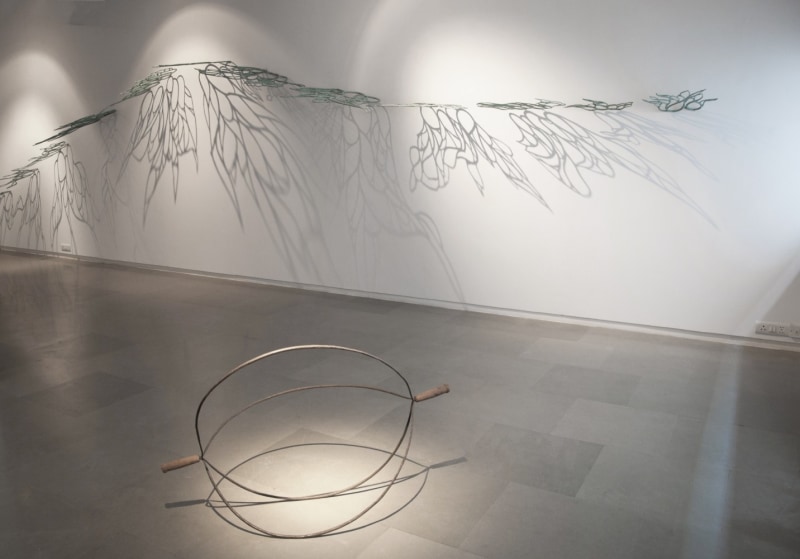
The gallery spaces are very quiet. Well suited to works like those of Karnataka-based artist Ranjani Shettar. As compellingly soft footfalls take you past the neatly nurtured greens that wait in welcome as you tread beyond the drive into the building, up towards the art works, what strikes here are the pristine white hues that pervade the dignity of uncluttered spaces. Minimal and unfussy, the place compares as a somewhat, personalized version of Delhi's haven, the IIC.
All in all six works are spaced out in Talwar Gallery, Neeti Bagh, corroborating the sanctity of unfilled spaces, summarily dispelling the horror of emptiness. The climate quite suits the mood of Ranjani's art. Scent of a Sound fills an entire room, the elements suspended from the ceiling, subtle and ephemeral, like floating clouds across the sky, or fleeting sounds unattainable once uttered. Made of bent stainless steel tubing, then wrapped up in muslin, secured with traditionally made glue, the work has a breathtaking quality.
Here is also in Aureole, the lights adjusted with loving care and utmost expertise form a vital part of the composition in a rich manipulation of shadows.
Stretch, a lone piece made in wood is placed directly on the floor. The grains have been lovingly followed, smoothened, and polished to perfection in an excellent exercise of truth to the material. To the Indian eye, it resembles a traditionally elaborate string instrument like the sitar, veena, or the esraj.
Lagoon plays on the depths of blue, again suspended in clusters from the ceiling, tactile and sensuous in lacquered wood. One can almost hear the water drops falling somewhere in the vicinity. In contrast, are two adaptations in homage to tools, basic and simple, mounted on the wall, rough wooden handles, and raw iron blades.
So it is no wonder that Ranjani chooses to live and work from a place a few miles away from Bangalore, for that is where she finds her ethos and her inspiration. In each one, one senses the birthing of work, from the awareness of earth to the spills of industry, in a slow muted process of combining the natural and the mechanical. The touch, the feel, the veneration all endure as the artist revels in one and utilizes the other in a superb unison of the old and the new.
The profile of such characteristically Indian works may well be on the rise, judging from Ranjani's relatively young career, which has included appearances in major biennials and one-person museum shows in the United States and Europe.
On view in numerous significant institutions and exhibitions worldwide, it can currently be seen at the Museum of Modern Art (MoMA), NY in "On Line: Drawing Through the Twentieth Century."
-Aruna Bhowmick